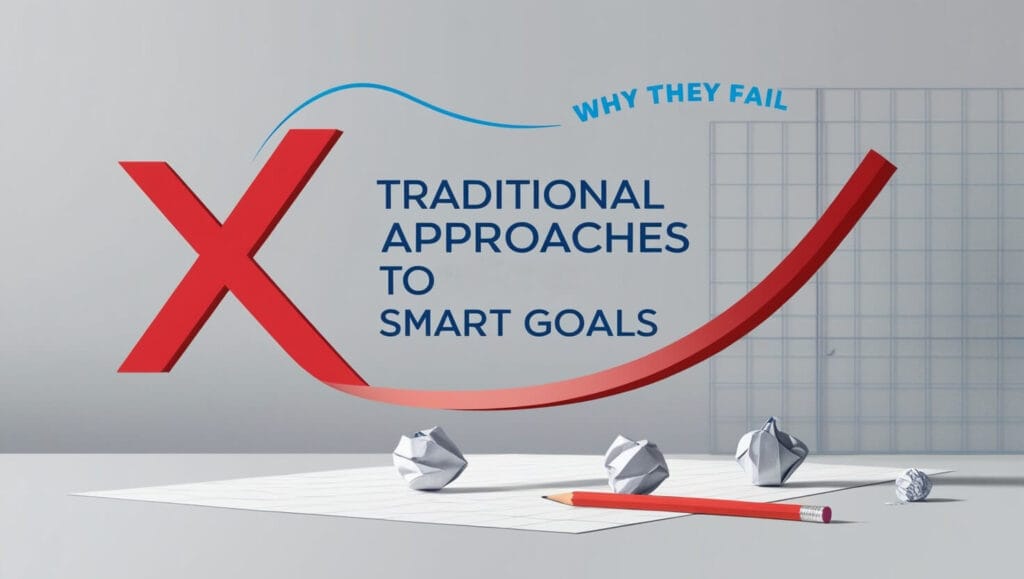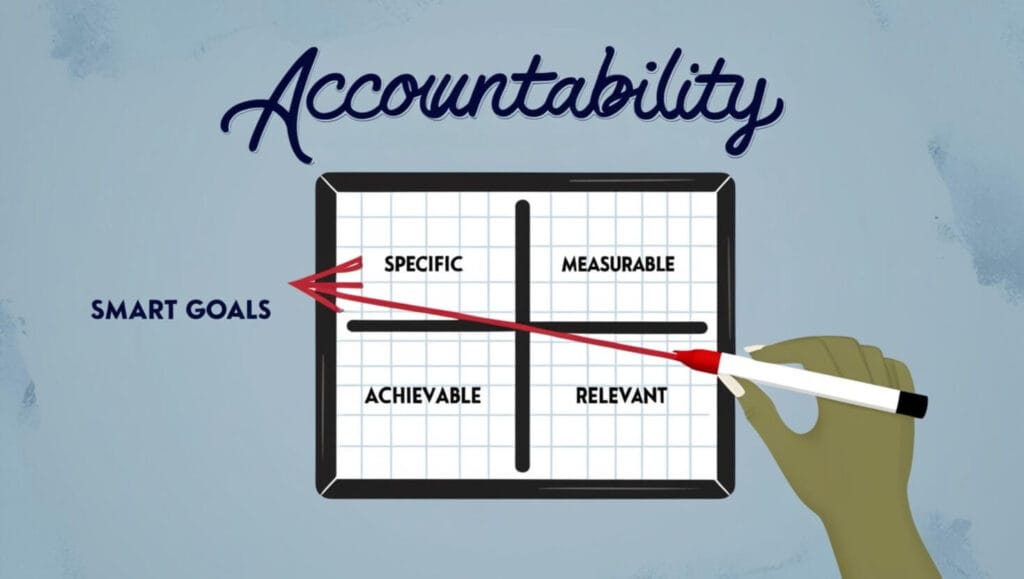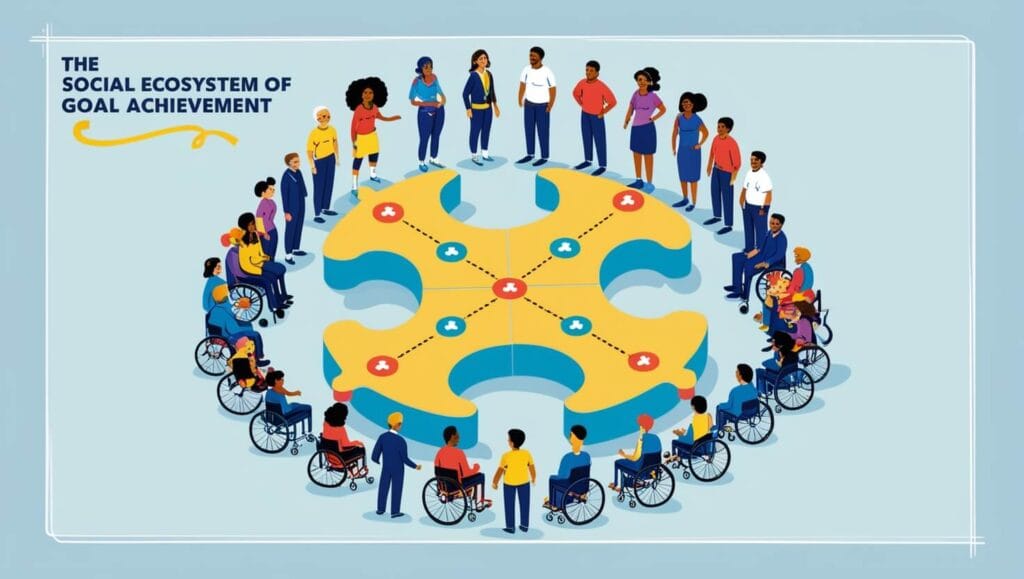
After coaching hundreds of professionals and analyzing thousands of goal-setting attempts, I’ve noticed a fascinating pattern – SMART goals, despite their logical structure, fail at an alarming rate. In fact, research shows that 92% of people who set goals at New Year’s abandon them by February, even when using the SMART framework.
But why do SMART goals fail so consistently? And more importantly, how can we fix these issues to make them work? Let’s dive deep into the real reasons behind these failures and explore practical solutions that actually work.
The Hidden Flaws in SMART Goal Setting
1. The “Specific” Paradox
While SMART goals emphasize being specific, this often becomes their downfall. Many people confuse being specific with being rigid. For example, “I will lose exactly 20 pounds in 3 months by going to the gym 5 times per week” sounds specific, but it leaves no room for life’s natural fluctuations.
The Fix: Instead of rigid specif-ics, create flexible ranges. Rather than “5 times per week,” try “4-6 gym sessions per week.” This builds in adaptability while maintaining clarity.
2. The Measurable Trap
Obsessing over measurements can actually derail progress. When people focus too heavily on numbers, they often lose sight of the qualitative aspects that drive real change. This is why SMART goals fail particularly often in personal development areas.
Consider someone wanting to improve their leadership skills. While they might measure “hours spent in leadership training,” this metric misses crucial elements like relationship building and emotional intelligence development.
The Fix: Combine quantitative metrics with qualitative indicators. For leadership development, track both training hours AND specific behavioral changes or feedback from team members.
3. The Attainability Illusion
SMART goals often fail because what seems “attainable” at the planning stage proves unrealistic in practice. We chronically underestimate the resources and energy required for achievement.
For instance, setting a goal to “write a novel in 6 months while working full-time” might seem attainable on paper, but the reality of consistent daily writing after long workdays tells a different story.
The Fix:
- Start with a “pilot period” of 2-3 weeks to test your goal’s attainability
- Track energy levels and resource usage during this period
- Adjust your timeline and expectations based on real data
4. The Relevance Disconnect
Many SMART goals fail because they lack deep personal relevance. People often set goals based on external expectations or superficial desires rather than core values.
The Fix: Before finalizing any goal, ask yourself:
- “Why does this matter to me personally?”
- “Would I pursue this if no one else knew about it?”
- “How does this align with my core values?”
5. The Time-Bound Pressure Cooker
Setting strict deadlines can create unnecessary pressure that leads to goal abandonment. When people fall slightly behind schedule, they often give up entirely rather than adjusting their timeline.
The Fix: Create milestone ranges instead of fixed deadlines. For example, rather than “achieve X by March 1st,” set a target window of “late February to mid-March.” This provides flexibility while maintaining momentum.
Why Traditional Approaches to SMART Goals Fail

The Psychology Behind Goal Failure
Most advice about why SMART goals fail focuses on the technical aspects while ignoring psychological factors. Research in behavioral psychology reveals several critical issues:
- Motivation Fluctuation Your brain’s motivation centers don’t maintain constant levels of enthusiasm. Understanding these natural cycles helps prevent giving up during low-motivation periods.
- Identity Conflict When SMART goals don’t align with your self-image, your subconscious mind often sabotages progress.
- Environmental Design Most people focus on willpower while ignoring their environment’s impact on goal achievement.
Advanced Solutions for SMART Goal Success
1. The Identity-First Approach
Instead of starting with the goal, start with identity. Ask yourself:
- “Who do I need to become to achieve this goal?”
- “What would this type of person do daily?”
- “How can I start acting like this person now?”
2. Environmental Optimization
Create an environment that makes success almost inevitable:
- Remove friction from desired behaviors
- Add friction to unwanted behaviors
- Design your space to support your goals
3. The Progress-Reframe Technique
Rather than focusing on the end goal, emphasize progress markers:
- Celebrate small wins extensively
- Track progress in multiple ways
- Share achievements with supportive people
- Document your journey
Implementation Strategy
To prevent SMART goals from failing, follow this revised framework:
- Planning Phase
- Define your goal using SMART criteria
- Add flexibility ranges to each element
- Create an environmental support plan
- Identify potential obstacles and solutions
- Testing Phase
- Run a two-week pilot period
- Track energy levels and resource usage
- Adjust goals based on real-world data
- Refine your environmental design
- Implementation Phase
- Focus on identity-based actions
- Monitor progress without obsessing
- Celebrate small wins consistently
- Adjust timelines as needed
The Role of Accountability in SMART Goal Achievement

One often overlooked aspect when discussing why SMART goals fail is the crucial role of accountability. Traditional advice suggests finding an accountability partner or joining a goal-setting group. However, my experience shows that the type and structure of accountability matters far more than its mere presence.
The Three Levels of Accountability
First-level accountability involves simple check-ins. While better than nothing, these surface-level interactions rarely prevent SMART goals from failing. Second-level accountability adds consequence – perhaps a financial stake or public commitment. But it’s third-level accountability that transforms goal achievement: this involves regular deep-dive sessions that examine not just progress, but process, obstacles, and necessary adjustments.
The Power of Systems Over Goals
While we’ve discussed why SMART goals fail, there’s a broader perspective to consider: the relationship between goals and systems. Goals define your destination, but systems determine your progress. When you focus exclusively on the SMART framework without building robust systems, failure becomes much more likely.
For example, instead of setting a SMART goal to “write a book in 6 months,” focus on building a daily writing system. This might include:
- Setting up a dedicated writing space
- Establishing a morning routine that leads to writing
- Creating templates for different types of chapters
- Developing a research organization system
The Feedback Loop Enhancement
Another critical factor in why SMART goals fail is inadequate feedback loops. Most people wait too long between setting goals and evaluating progress. By implementing rapid feedback cycles – as short as daily or weekly – you can identify and correct issues before they derail your entire goal.
Consider using a “daily score” system where you rate your goal-related actions on a scale of 1-10. This immediate feedback helps maintain momentum and provides early warning signs when motivation or progress begins to slip.
The Motivation-Habit Balance
A fascinating aspect of why SMART goals fail involves the relationship between motivation and habits. While initial goal-setting relies heavily on motivation, long-term success depends on habit formation. Understanding this transition is crucial for sustainable achievement.
The key is to use your initial motivation surge to establish habits that will carry you through when that motivation inevitably wanes. Think of motivation as the rocket fuel that helps you escape Earth’s atmosphere, while habits are the efficient engines that keep you moving through space.
Integrating Flexibility Without Losing Focus
One final crucial element in preventing SMART goals from failing is mastering the art of flexible persistence. This means maintaining unwavering commitment to your ultimate objective while remaining flexible about the path to get there.
Consider implementing a “weekly review and adjust” protocol where you:
- Evaluate progress against your original plan
- Identify what’s working and what isn’t
- Make strategic adjustments to your approach
- Recommit to your core objective while being flexible about methods
This balance between consistency and adaptability often determines whether your SMART goals succeed or join the statistics of why SMART goals fail.
Remember, the ultimate measure of success isn’t just achieving your goal – it’s who you become in the process. By understanding and addressing these deeper aspects of goal achievement, you can transform the SMART framework from a simple planning tool into a powerful catalyst for personal growth and success.
The Psychology of Goal Evolution

An often-neglected aspect of why SMART goals fail lies in their static nature versus our dynamic psychological needs. As we progress toward our goals, our understanding, capabilities, and even desires often shift. Yet, many people cling rigidly to their original SMART goals, leading to decreased motivation and eventual abandonment.
The Dynamic Goal Adjustment Protocol
Instead of viewing your SMART goals as fixed targets, consider implementing a Dynamic Goal Adjustment Protocol. This approach involves:
Understanding Phase Transitions As you progress toward your goal, you’ll encounter different phases, each requiring unique strategies and mindsets. For example, when learning a new skill, you move through distinct stages of competence. Your goals should evolve to match these transitions.
Regular Vision Alignment Schedule monthly “vision alignment” sessions where you ask yourself:
- Does this goal still align with my evolving vision?
- Have I discovered new aspects that should be incorporated?
- Are there elements that no longer serve my growth?
The Hidden Power of Micro-Commitments
While discussing why SMART goals fail, we must address the overwhelming nature of significant objectives. Even when broken down into smaller steps, many people struggle with consistent execution. This is where the concept of micro-commitments becomes invaluable.
The Two-Minute Rule Enhanced
Building on James Clear’s two-minute rule, develop a system of progressive micro-commitments. Start with actions so small they seem almost trivial. For instance, if your goal involves fitness, begin with a commitment to put on your workout clothes. That’s it. No pressure to exercise – just dress the part.
As these micro-commitments become habitual, naturally expand them. The key is that this expansion happens organically, driven by your own motivation rather than external pressure.
Emotional Intelligence in Goal Achievement
The emotional aspect of why SMART goals fail rarely receives the attention it deserves. Your emotional state dramatically impacts your ability to pursue and achieve goals, yet most goal-setting frameworks focus purely on logical planning.
The Emotional Success Journal
Implement an Emotional Success Journal specifically focused on your goal journey. Track not just what you do, but how you feel about your progress. This helps you:
- Identify emotional patterns that affect your motivation
- Recognize early signs of burnout or overwhelm
- Celebrate emotional victories, not just tactical achievements
- Develop greater self-awareness in your goal pursuit
The Environment-First Approach
While most discussions about why SMART goals fail focus on personal discipline and motivation, the role of environment design cannot be overstated. Your physical and social environment either supports or sabotages your goals.
Creating Success Triggers
Instead of relying solely on willpower, strategically place “success triggers” throughout your environment. These are physical or digital cues that prompt goal-supporting behaviors. For example:
- Place your running shoes by your bed if morning exercise is your goal
- Set up automated bill payments for financial goals
- Create calendar blocks for important goal-related activities
The Social Ecosystem of Goal Achievement

One under-discussed reason why SMART goals fail relates to social dynamics. We often overlook how our relationships and social environment profoundly impact our ability to achieve goals. Let’s explore how to build a supportive social ecosystem that enhances rather than hinders goal achievement.
The Circle of Influence Audit
Most people never conduct a thorough analysis of how their social connections affect their goals. Perform a Circle of Influence Audit by categorizing your regular contacts into three groups:
- Goal Accelerators: People who actively support and enhance your progress
- Neutral Influences: Those who neither significantly help nor hinder your goals
- Progress Inhibitors: People who (intentionally or not) make goal achievement harder
The key isn’t to cut people out of your life, but to consciously manage your exposure and energy investment based on their impact on your goals.
The Power of Progress Rituals
While exploring why SMART goals fail, we often overlook the importance of celebrating progress effectively. Many people either skip celebrations entirely or celebrate in ways that actually undermine their goals (like rewarding healthy eating with junk food).
Designing Effective Progress Rituals
Create progress rituals that reinforce rather than contradict your goals:
- For fitness goals, reward progress with new workout gear or healthy cooking classes
- For learning goals, celebrate milestones by purchasing books or attending relevant workshops
- For financial goals, set aside a small percentage of savings for experiences that create memories
The Meta-Learning Approach
One fascinating aspect of why SMART goals fail involves our approach to learning from failure. Most people either ignore failures or become discouraged by them, missing the opportunity for meta-learning – learning about how we learn and achieve goals.
The Failure Analysis Protocol
Implement a structured Failure Analysis Protocol:
- Document what didn’t work without judgment
- Identify patterns in challenges and obstacles
- Analyze your response to setbacks
- Extract specific lessons for future goal-setting
- Adjust your approach based on these insights
The Energy Management Revolution
Traditional discussions about why SMART goals fail rarely address energy management. We often focus on time management while ignoring that energy, not time, is often the limiting factor in goal achievement.
Energy Optimization Strategies
- Peak Performance Mapping
- Track your energy levels throughout the day
- Identify your personal high-energy periods
- Schedule crucial goal-related tasks during these peaks
- Energy Recovery Protocols
- Design specific recovery activities that recharge you
- Schedule regular energy audit sessions
- Create emergency energy restoration plans for difficult periods
The Integration Mindset
A critical factor in why SMART goals fail is the false separation between “goal activities” and “regular life.” Successful goal achievement requires integration rather than separation.
The Lifestyle Integration Framework
Develop ways to blend goal-related activities into your existing routines:
- Turn commute time into learning time for educational goals
- Transform social activities to align with fitness goals
- Integrate financial goals into daily spending decisions
Remember, sustainable goal achievement isn’t about drastic life changes, but about intelligent integration of new behaviors into your existing lifestyle.
Building Resilient Progress Systems
The final piece in understanding why SMART goals fail involves building systems that can withstand life’s inevitable disruptions. Most goal-setting approaches assume ideal conditions, leading to collapse when reality intervenes.
Creating Disruption-Proof Systems
- Develop multiple paths to progress
- Build buffer time into your timelines
- Create contingency plans for common obstacles
- Establish minimum viable progress standards
- Design flexible backup systems for crucial habits
The key to long-term success isn’t avoiding disruptions but building systems that can absorb and adapt to them.
The Role of Mental Models in Goal Achievement

Understanding why SMART goals fail often requires examining the mental models we use to approach them. Our underlying beliefs and thought patterns can either support or sabotage our efforts, regardless of how well we structure our goals.
Shifting from Linear to Cyclical Progress
One of the most damaging mental models is viewing progress as linear. This perspective makes every setback feel like a failure, contributing to why SMART goals fail so frequently. Instead, adopt a cyclical model of progress that recognizes natural ebbs and flows.
Consider progress like the seasons:
- Spring: Period of new growth and enthusiasm
- Summer: Peak performance and momentum
- Autumn: Natural slowing and consolidation
- Winter: Rest and preparation for next cycle
This model helps you maintain perspective during inevitable downtimes and prevents the common “all or nothing” mindset that derails many goals.
Advanced Decision-Making Frameworks
Another critical factor in why SMART goals fail involves poor decision-making processes. Even well-structured goals require countless small decisions along the way, and the quality of these decisions significantly impacts success.
The Three-Level Decision Filter
Before making any goal-related decision, run it through these filters:
- Alignment Check: Does this choice align with my core goal?
- Resource Assessment: Do I have the necessary resources (time, energy, money) to support this decision?
- Sustainability Evaluation: Can I maintain this choice long-term?
The Momentum Management System
Understanding momentum is crucial when examining why SMART goals fail. Many people focus on making progress without considering how to maintain and manage momentum effectively.
Building Sustainable Momentum
- Identify Key Momentum Indicators
- Track daily energy levels
- Monitor motivation patterns
- Measure progress consistency
- Note environmental factors
- Create Momentum Protection Protocols
- Establish minimum daily actions
- Design recovery strategies
- Build support systems
- Plan for obstacles
The key is recognizing that momentum is a resource that needs active management, not just an outcome of good habits.
The Hidden Role of Identity in Goal Achievement

When investigating why SMART goals fail, we often overlook the profound impact of self-identity. Many goals fail not because of poor planning or lack of effort, but because they conflict with our deep-seated beliefs about who we are.
The Identity Alignment Process
Before setting any SMART goal, conduct an identity audit:
- Examine your current self-image
- Identify beliefs that might conflict with your goal
- Create identity bridges between who you are and who you need to become
- Develop specific identity-shifting practices
For example, if your goal is to become a successful entrepreneur but you’ve always seen yourself as a “safe player,” you’ll need to gradually shift this identity through small entrepreneurial actions and mindset work.
The Power of Micro-Environments
Another overlooked aspect of why SMART goals fail involves the impact of micro-environments – the small, immediate spaces where we spend most of our time. While we might consider our broader environment, these intimate spaces often have the most significant impact on our behavior.
Creating Success-Triggering Spaces
Transform your immediate environment to support your goals:
- Your workspace: Organize it to minimize distractions and maximize focus
- Your phone: Restructure apps and notifications to support rather than hinder progress
- Your morning environment: Design it to trigger positive habits automatically
- Your evening space: Create an environment that facilitates reflection and planning
The Feedback Loop Revolution
Many SMART goals fail because of inadequate or improper feedback systems. Traditional advice suggests tracking progress, but the type and timing of feedback can make or break your success.
Designing Effective Feedback Systems
- Immediate Feedback Loops
- Create instant notification systems for key behaviors
- Establish quick win markers throughout your day
- Develop rapid response protocols for obstacles
- Intermediate Feedback Cycles
- Weekly progress reviews
- Monthly strategy assessments
- Quarterly goal alignment checks
- Long-term Feedback Integration
- Regular identity alignment checks
- System optimization reviews
- Environmental impact assessments
Advanced Strategies for SMART Goal Success
The Meta-System Approach
One of the most sophisticated strategies for preventing SMART goals from failing involves creating a meta-system – a system that monitors and optimizes your other goal-achievement systems.
Components of an Effective Meta-System:
- Performance Analytics Dashboard
- Track multiple success metrics simultaneously
- Monitor both leading and lagging indicators
- Identify correlations between different behaviors
- Map energy expenditure against results
- Calculate return on effort invested
- Adaptive Response Protocols When your meta-system detects potential issues, it should trigger specific responses:
- Early warning interventions
- Resource reallocation procedures
- Strategy adjustment protocols
- Emergency support activation
- Momentum preservation tactics
The Deep Implementation Protocol
Most SMART goals fail during the implementation phase. This advanced protocol ensures deeper, more sustainable implementation:
- Progressive Loading Instead of diving in at full intensity, use a graduated approach:
- Week 1-2: 30% of target intensity
- Week 3-4: 50% of target intensity
- Week 5-6: 70% of target intensity
- Week 7-8: 85% of target intensity
- Week 9+: Full implementation
- Neural Reinforcement Create multiple neural pathways to support your goal:
- Visual reinforcement through imagery
- Kinesthetic anchoring through physical movement
- Auditory programming through specific sounds or music
- Written reinforcement through journaling
- Verbal reinforcement through self-talk
The Psychological Firewall
Build psychological defenses against common goal-derailing factors:
- Identity Protection Protocols
- Create specific responses to identity threats
- Develop identity reinforcement rituals
- Establish identity evolution markers
- Design identity integration practices
- Motivation Insurance Systems
- Build redundant motivation sources
- Create motivation regeneration protocols
- Establish minimum viable motivation levels
- Design emergency motivation restoration procedures
The Flow State Integration System
Leverage flow states to accelerate goal achievement:
- Flow Triggers
- Identify personal flow triggers
- Design environment for flow state access
- Create pre-flow preparation rituals
- Establish flow state protection protocols
- Flow State Optimization
- Map optimal challenge levels
- Track flow state duration
- Monitor flow state quality
- Measure flow state outcomes
The Advanced Habit Stacking Protocol
Moving beyond basic habit stacking, this protocol creates sophisticated behavioral chains that mutually reinforce your goals:
- Primary Habit Anchors
- Identify cornerstone habits
- Create habit hierarchies
- Design trigger sequences
- Establish backup triggers
- Cross-Pollination Benefits Develop habits that simultaneously support multiple goals:
- Morning routine that builds mental clarity and physical fitness
- Reading practices that enhance both professional knowledge and personal growth
- Social activities that combine networking and skill development
The Decision Fatigue Prevention System

Advanced decision-making frameworks to prevent goal derailment:
- Pre-Decision Protocols
- Create decision matrices for common scenarios
- Establish clear decision boundaries
- Design rapid decision-making frameworks
- Develop contingency decision trees
- Energy Conservation Strategies
- Automate routine decisions
- Batch similar decisions
- Create decision-free zones
- Establish decision deferral criteria
Final Implementation Framework
To bring all these advanced strategies together:
Phase 1: Foundation Building (Weeks 1-4)
- Establish meta-system basics
- Initialize psychological firewall
- Begin progressive loading
- Set up primary habit anchors
Phase 2: System Integration (Weeks 5-8)
- Activate flow state protocols
- Implement decision frameworks
- Develop cross-pollination habits
- Fine-tune feedback loops
Phase 3: Advanced Optimization (Weeks 9-12)
- Enhance meta-system complexity
- Strengthen psychological defenses
- Maximize flow state integration
- Perfect habit stacking sequences
The Future of SMART Goal Achievement

Understanding why SMART goals fail is just the beginning. By implementing these advanced strategies, you create a robust system that not only prevents failure but accelerates success. Remember that the key to extraordinary achievement lies not in working harder, but in working smarter through sophisticated systems and strategies.
Your goal achievement journey is unique, and these advanced strategies should be adapted to fit your specific circumstances. Start with the elements that resonate most strongly with you, and gradually incorporate others as your capacity grows.
The future of goal achievement isn’t about simple target setting – it’s about creating intelligent, adaptive systems that evolve with you. By implementing these advanced strategies, you’re not just working toward your current goals; you’re building a foundation for lifetime achievement.
Final Thoughts
Success in goal achievement isn’t just about reaching targets – it’s about becoming the person capable of achieving those targets. Through the implementation of these advanced strategies, you’re not just building better goals; you’re building a better you.
Remember: The question isn’t just why SMART goals fail, but how we can transform them into launching pads for extraordinary achievement. Start implementing these strategies today, and watch as your goal achievement capabilities evolve to new levels of sophistication and success.
This article was written by a human writer using AI automation tools to segregate content, improve syntax and spelling, and present the article in a readable and understandable way.


